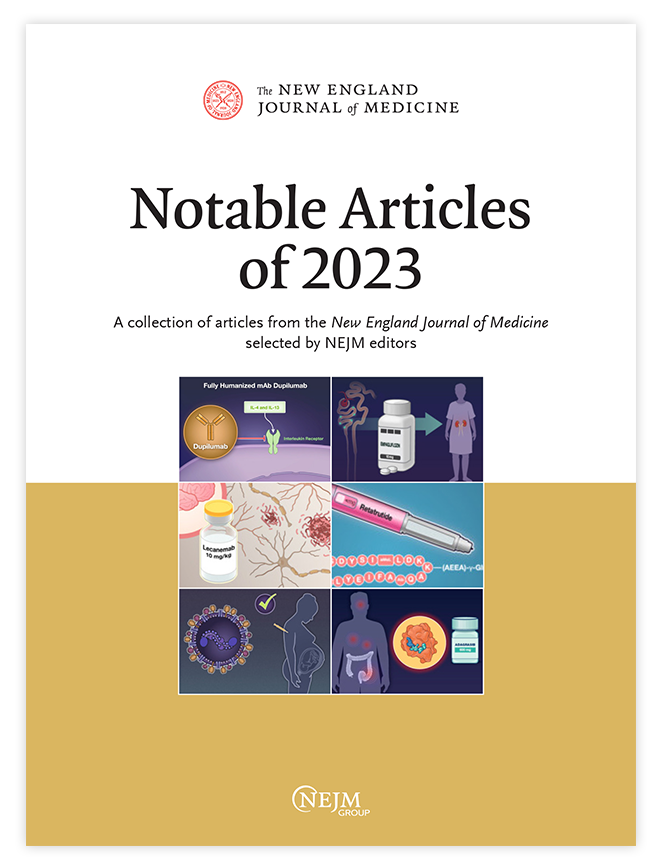Ivermectin to Control Malaria - A Cluster-Randomized Trial.
IF 78.5
1区 医学
Q1 MEDICINE, GENERAL & INTERNAL
引用次数: 0
Abstract
BACKGROUND Malaria control and elimination is threatened by the spread of insecticide resistance and behavioral adaptation of vectors. Whether mass administration of ivermectin, a broad-spectrum antiparasitic drug that also kills mosquitoes feeding on treated persons, can reduce malaria transmission is unclear. METHODS We conducted a cluster-randomized trial in Kwale, a county in coastal Kenya in which malaria is highly endemic and coverage and use of insecticide-treated nets are high. Clusters of household areas were randomly assigned in a 1:1 ratio to receive mass administration of ivermectin (400 μg per kilogram of body weight) or albendazole (400 mg, active control) once a month for 3 consecutive months at the beginning of the "short rains" season. Children 5 to 15 years of age were tested for malaria infection monthly for 6 months after the first round of treatment. The two primary outcomes were the cumulative incidence of malaria infection (assessed among children 5 to 15 years of age) and of adverse events (assessed among all eligible participants). Analyses were performed with generalized estimating equations in accordance with the intention-to-treat principle. RESULTS A total of 84 clusters comprising 28,932 eligible participants underwent randomization. The baseline characteristics of the participants were similar in the trial groups. Six months after the first round of treatment, the incidence of malaria infection was 2.20 per child-year at risk in the ivermectin group and 2.66 per child-year at risk in the albendazole group; the adjusted incidence rate ratio (ivermectin vs. albendazole) was 0.74 (95% confidence interval [CI], 0.58 to 0.95, P = 0.02). The incidence of serious adverse events per 100 treatments did not differ significantly between the trial groups (incidence rate ratio, 0.63; 95% CI, 0.21 to 1.91). CONCLUSIONS Among children 5 to 15 years of age who were living in an area with high coverage and use of bed nets, ivermectin, administered once a month for 3 consecutive months, resulted in a 26% lower incidence of malaria infection than albendazole. No safety concerns were identified. (Funded by Unitaid; BOHEMIA ClinicalTrials.gov number, NCT04966702; Pan African Clinical Trial Registry number, PACTR202106695877303.).伊维菌素控制疟疾-一项集群随机试验。
疟疾的控制和消除受到杀虫剂耐药性蔓延和媒介行为适应的威胁。伊维菌素是一种广谱抗寄生虫药物,也能杀死以接受治疗的人为食的蚊子。大规模使用伊维菌素是否能减少疟疾传播尚不清楚。方法我们在肯尼亚沿海的Kwale县进行了一项聚类随机试验,该县疟疾高度流行,驱虫蚊帐的覆盖率和使用率很高。在“短雨”季节开始时,按1:1的比例随机分配成组的家庭区域,每月一次,连续3个月接受伊维菌素(每公斤体重400 μg)或阿苯达唑(400 mg,主动对照)的大规模给药。在第一轮治疗后的6个月内,对5至15岁儿童每月进行疟疾感染检测。两个主要结局是疟疾感染的累积发生率(在5至15岁的儿童中评估)和不良事件的累积发生率(在所有符合条件的参与者中评估)。根据意向处理原则,用广义估计方程进行分析。结果84组共28,932名符合条件的参与者被随机分组。试验组参与者的基线特征相似。在第一轮治疗后6个月,伊维菌素组的疟疾感染发生率为2.20 /儿童年,阿苯达唑组为2.66 /儿童年;调整后的发病率比(伊维菌素vs阿苯达唑)为0.74(95%可信区间[CI], 0.58 ~ 0.95, P = 0.02)。每100次治疗的严重不良事件发生率在试验组之间无显著差异(发生率比,0.63;95% CI, 0.21 ~ 1.91)。结论在高蚊帐覆盖率地区5 ~ 15岁儿童中,每月1次使用伊维菌素,连续使用3个月,疟疾感染率比阿苯达唑低26%。没有发现安全隐患。(Unitaid资助;BOHEMIA ClinicalTrials.gov编号:NCT04966702;泛非临床试验注册号PACTR202106695877303)。
本文章由计算机程序翻译,如有差异,请以英文原文为准。
求助全文
约1分钟内获得全文
求助全文
来源期刊

New England Journal of Medicine
医学-医学:内科
CiteScore
145.40
自引率
0.60%
发文量
1839
审稿时长
1 months
期刊介绍:
The New England Journal of Medicine (NEJM) stands as the foremost medical journal and website worldwide. With an impressive history spanning over two centuries, NEJM boasts a consistent publication of superb, peer-reviewed research and engaging clinical content. Our primary objective revolves around delivering high-caliber information and findings at the juncture of biomedical science and clinical practice. We strive to present this knowledge in formats that are not only comprehensible but also hold practical value, effectively influencing healthcare practices and ultimately enhancing patient outcomes.
 求助内容:
求助内容: 应助结果提醒方式:
应助结果提醒方式:


